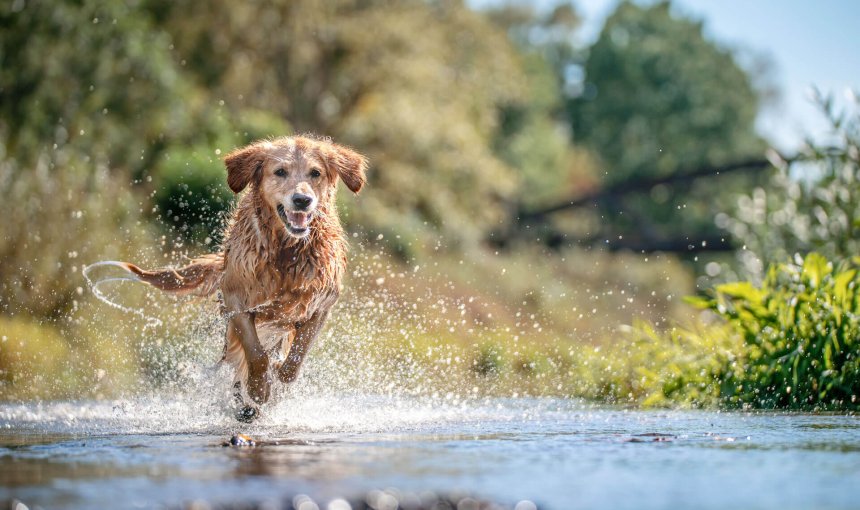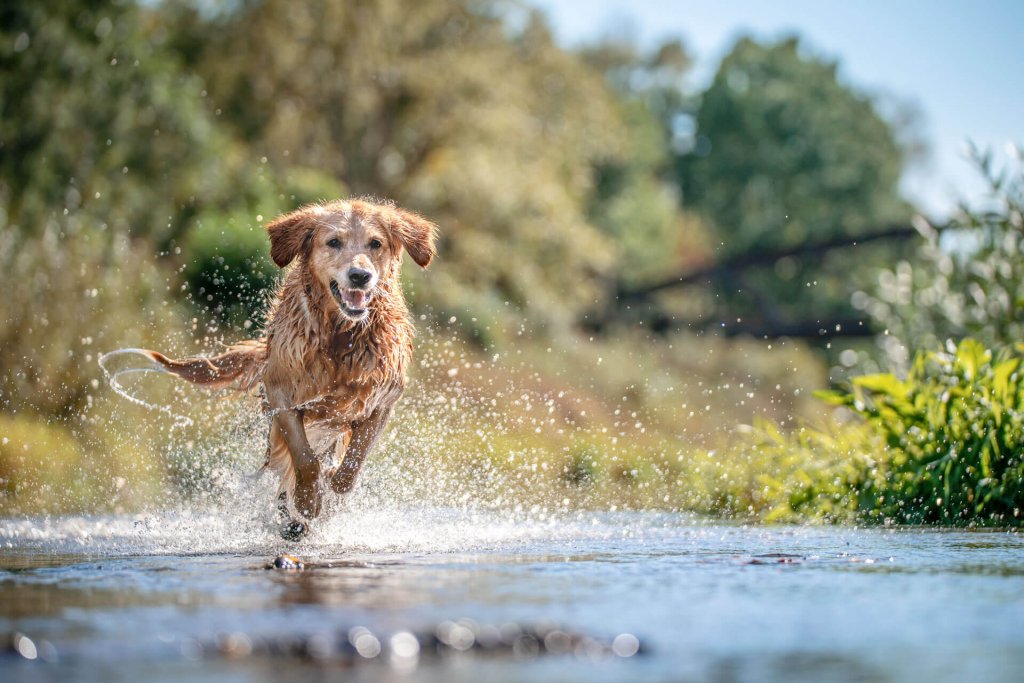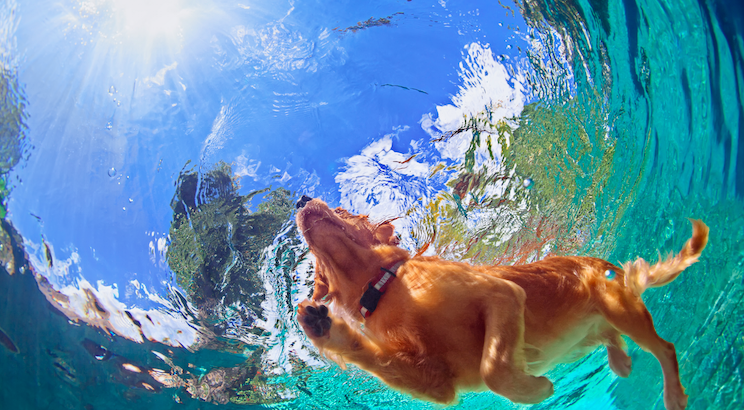Can My Dog Swim? A Guide To Safe And Fun Swimming With Dogs!
Swimming is a great warm-weather activity for you and your dog to enjoy together. Read these tips to keep your pooch safe and help them learn to love the water.

Nothing beats splashing in cool water on a hot day – for people and for dogs, too! But despite having a swimming stroke named after them (the Dog Paddle, of course), not all dogs are natural-born swimmers. With the right preparation, you and your pup can still enjoy a refreshing dip at the local pool or swimming hole. And while you’re out, be aware of the risk of heat stroke in dogs. Plus, consider adding a GPS dog tracker to your dog’s collar – so you’ll be able to find your dog anywhere.
Can all dogs swim?
Technically, any dog can swim if they are in good health and are properly introduced to swimming. Some dog breeds have a knack for swimming, while other dog breeds have body types that aren’t well-suited for this activity. Of course how well a dog can swim depends not only on their breed, but on their individual personality and experiences.
Dog breeds that like to swim
Golden retrievers and labrador retrievers were bred to retrieve waterfowl for hunters, so they are typically comfortable entering bodies of water and swimming. Spanish water dogs, portuguese water dogs, and american water spaniels, as their names imply, often have a natural affinity for water.
Discover more dogs that can swim in this article: Water Dog Breeds: 19 Dog Breeds That Love Water
Dog breeds that can’t swim
Then of course, there are some dog breeds which don’t make great swimmers. For example, dogs with short legs and long bodies such as basset hounds, corgis, and dachshunds may struggle to maneuver in deep water.
Additionally, dog breeds with flat faces like pugs, french bulldogs, and pekingese may have a hard time breathing while swimming, because they must tilt their head up to breathe. Bulldogs have a hard time swimming due to their body’s natural weight distribution.
So don’t forget a dog life vest if you take any of these dogs near the water.
Does your dog love water?
Even if a dog breed is supposed to love water, some individual dogs simply don’t enjoy getting wet. But nearly any dog can come to love the water, even if it’s just wading in up to their ankles.

How to get a dog to like water
Getting your dog to love being in the water and swimming starts the same as any new activity with your dog: a gradual introduction, built on a foundation of trust between you and your sweet pup.
Make your pooch’s first experience in the water a positive one. On your first visit, test your dog’s interest in the water. Wade in and see if they follow you.
Allow your pooch to set the pace for how deep they’ll go into the water. Stay right by their side and offer verbal praise. It may take a few visits to the water before your pup is willing to plunge in. Just be patient and encouraging.
A plastic kiddie pool is another good starting point for getting your dog comfortable in the water. Choose the hard plastic type of kiddie pool, not an inflatable pool, which can be punctured by your dog’s toenails. Set the kiddie pool up in your backyard and add a few inches of water. Allow the water to warm in the sun for an hour or two. The kiddie pool’s slippery surface may not work for your dog, so lay some rubber mats on the pool’s floor for traction. Toss in some favorite toys. Hang out close by your furry friend and offer treats and praise each time they enter the water.
Don’t start doggie swim lessons by throwing a ball into the ocean and having your dog chase it into the waves. They have no idea that the water gets deeper, or that a wave will suddenly knock them down. Your dog may panic and as a result could refuse to enter the water ever again.
Using a dog life jacket for safety
Keeping your furry friend safe is a top priority. So make sure your dog has a properly fitting dog flotation device for each swim session. A dog life jacket will help your pooch feel confident in the water, and you’ll have peace of mind knowing that they are safe from disaster. (Speaking of peace of mind, a GPS dog tracker can be a lifesaver, too.)
10 Lost Dog Stories With A Happy Ending Thanks To Tractive GPS
Dogs with low body fat can benefit from a dog life jacket, because they may not stay afloat easily. Without a dog life jacket, these lean-bodied dogs have to work extra hard to keep their heads above water and could quickly become exhausted.
Choose a dog life jacket made from waterproof materials and make sure it fits your dog properly. If you are boating with your dog, a life jacket with a handle allows you to lift your pup out of the water if they should fall overboard. A life jacket with a D-ring is handy, allowing you to attach a leash while you walk on the beach with your dog.
Don’t assume that because your dog is a breed that loves water, they will be safe without a life jacket. Any dog could still get into trouble if left alone, especially in the ocean. Never allow your dog to swim without supervision.

Always know where your dog is
Follow every step in real-time with unlimited range. Get alerts if they wander too far. Keep them happy & healthy with Wellness Monitoring. And let others – like walkers or sitters – keep an eye on your dog too.
Choosing the location to go swimming with your dog
The options for places to swim with your dog are many. Your choice of location may depend on how comfortable your dog is in the water, your own lifestyle, and how far you are willing to travel.
Dogs and salt water swimming
We’ve all seen images of dogs catching an ocean wave while perched on a doggie-sized surfboard. Don’t expect this on your first visit to the beach with your pup! The ocean is powerful and best enjoyed cautiously, especially if you are visiting with your dog for the first time.
Start by walking the beach (with your dog leashed and wearing a dog life jacket). Experience the waves as they wash up on the sand. Seagulls, crabs, seaweed, and people will be of great interest to your pooch. Take a few steps into the water, just up to your ankles, and see how your dog reacts. They may like it, or they may be afraid. Keep the visit positive and don’t force your dog to go in the water, and never trick them by tossing a ball for them to chase into the ocean.
Currents, riptides, and waves can overwhelm dogs just like they do to humans. Also, ingesting too much saltwater can cause problems ranging from mild diarrhea to death. Be sure to offer your dog fresh water to drink when at the beach.

Fresh-water swim: dog safety at lakes and ponds
Lakes and ponds can be good choices for introducing your pup to the water. When entering a lake or pond from the shore, the water depth increases gradually, so your dog can go only as deep as they want to. While large lakes, such as the Great Lakes in the US, may have waves and strong currents, smaller lakes and ponds typically have little or no wave action.
Once your dog gets its feet wet and seems comfortable, try carrying your dog into the water. Or, you might bring along a doggie friend and let your dog watch them swim exuberantly in the lake. Your pup may decide to join the fun. Remember to put the dog life jacket on your furry friend for safety.
In some areas, blue-green algae can grow in ponds and lakes during hot summer weather. Also known as cyanobacteria, blue-green algae can cause a range of reactions including minor eye irritation, vomiting, diarrhea, lethargy, and even death. If the water looks discolored, smells bad, has lots of visible algae on the surface, or official warnings have been posted about blue-green algae, you and your dog should stay out of the water.
Can Your Dog Swim in the Pool?
Backyard swimming pools are generally considered safe places for dogs to swim under your supervision. When first entering a pool, you might want to carry your dog until they get comfortable, since most pools are too deep for a dog to stand in. Teach your pup where the pool’s exit points are so they can know in advance. A dog may not find the pool steps or ramp on their own.
Allowing your dog to swim in the backyard swimming pool can be tons of fun for the whole family, but recognize that there are some downsides.
Dogs have a lot more hair than people do, and that hair will end up in your pool’s filtration system. Dogs often have debris in their fur, including dirt, pollen, and even fecal matter, which can contaminate the swimming pool. Dogs’ toenails can tear the pool liner or puncture inflatable pool toys.
If you decide to invite your pup into your swimming pool, brush and rinse them before the swim session. This will reduce the amount of debris that accompanies your pooch into the pool.
Check your community pool to see if they offer dog swim days. Many seasonal community pools schedule a day for dogs to swim once the swimming pool closes to people at the end of summer.
Is pool water safe for dogs?
Everyone swallows some water in a swimming pool, but don’t allow your dog to drink lots of pool water. Lapping up a large volume of pool water can cause stomach upset, diarrhea, or vomiting.
The chemicals used to maintain swimming pool water quality can irritate your pup’s skin and eyes, especially if they swim often. After your dog exits the pool, give them a good rinse with the garden hose to avoid itchy, dry skin.
Be sure that hazardous pool chemicals and chlorine are locked away, out of reach of your children and pets.
How cold is too cold for dogs to swim?
Just like humans, dogs can get hypothermia from swimming for long periods in water that is too cold. Hypothermia occurs when the body loses heat faster than it can produce heat, resulting in a dangerously low body temperature.
Experts say that a good benchmark is to add the air temperature and the water temperature readings. These two numbers should equal at least 100 degrees Fahrenheit to avoid cold water hypothermia. Another good rule of thumb: If its’ too cold for you to swim without a wet suit or dry suit, it’s too cold for your dog.
Don’t leave your dog unsupervised
All bodies of water, from pools to oceans, can be dangerous for pets and for people. Treat your pup like you would small children: do not allow them near the water or swimming pool without your constant supervision. This includes letting your dog out to do their business if they have access to a backyard pool. Your swimming pool should have a safety cover rather than a floating cover, which dogs and children can become trapped beneath if they should fall in.

What are the benefits of swimming for your dog?
Everyone knows that swimming is a great way for people to stay in shape or recover from injury, and the same is true for your dog.
It’s joint-friendly
If your dog struggles with arthritis, dysplasia, or has an orthopedic injury, the pool is a great place for rehab. Swimming is low-impact and non-weight-bearing, so it does not put stress on joints and tendons. Swimming in warm water can relieve pain, promote blood flow, and help with injury recovery. Talk to your veterinarian about hydrotherapy for your dog’s recovery.
It’s great for overweight dogs
Dogs that are overweight or obese often have difficulty moving on land. When swimming, overweight dogs can be active with less risk of strain or injury. Along with dietary changes, swimming can help heavy dogs lose weight.
It improves overall health
Experts say that one minute of swimming is equivalent to four minutes of running. Swimming builds aerobic capacity and improves circulation.
Another bonus of taking your dog swimming: It can provide stress relief and improve overall well-being. Swimming offers playtime with you, their favorite human, while moving unrestrained and free from the leash. Active dogs get worn out and get restorative sleep, which is the foundation of good health.
After swim dog care
One hazard of water play – the dreaded “wet dog” smell. Once your dog’s swim session is over, give them a good rinse, dry with a towel, and brush thoroughly. Carefully dry your dog’s ears to avoid possible infection, especially in dogs with floppy ears like Labrador retrievers. Check your pup for ticks and cuts.
Swimming is hard work, so offer your pooch plenty of fresh drinking water afterwards, and maybe a treat or two.
Once your pup is clean, dry, and worn out from their swim, spread out a blanket in the shade and take a well-deserved nap!
P.S. Like what you’ve read? Subscribe to the Tractive newsletter for more articles like this or share this post with a friend:




